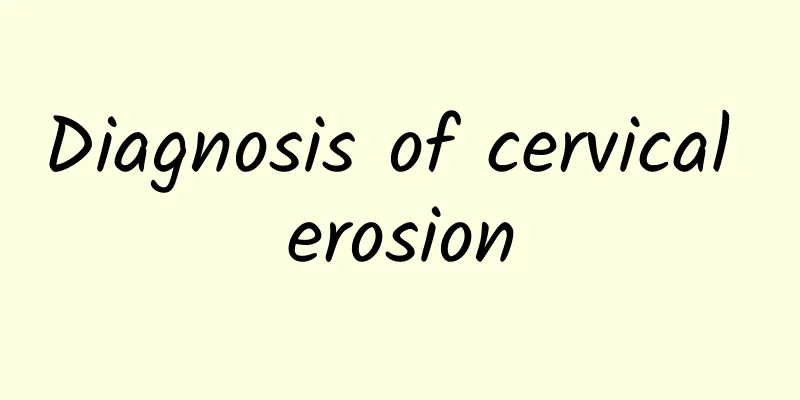Diagnosis of cervical erosion

|
Cervical erosion is one of the local characteristics of chronic cervicitis. For a long time, clinicians have regarded chronic cervicitis and cervical erosion as synonyms. However, according to the different pathological processes, cervical erosion is divided into the following types when diagnosing cervical erosion. 1. Pseudo-erosion: The pathological concept of erosion refers to "the shedding of the surface epithelium", and the common cervical erosion in clinical work is mostly the red area around the external cervical opening. During colposcopy, after applying 3% acetic acid on the surface of the red area, it can be seen that the red area has a "grape cluster" change, which is caused by columnar epithelial edema. If a biopsy is performed on this area, columnar epithelium can be seen on the surface under a microscope. Therefore, if the pathological definition of erosion is strictly followed, this does not belong to erosion, so some people suggest calling it pseudo-erosion. Most of the cervical erosion seen in clinical work belongs to this type. 2. True erosion: Since the surface of the cervix is often covered with a lot of mucus or purulent secretions, these secretions stimulate and soak the squamous epithelium around the external cervical opening for a long time. In addition, the inflammatory infiltration of the deep tissues of the cervix causes the squamous epithelium covering the surface of the cervix to lose vitality and fall off, forming an ulcer, which is true erosion. However, this erosion surface is quickly covered by the surrounding columnar epithelium, forming a granular, shiny red area, which is false erosion. The cervical erosions we find in our daily work are mostly false erosions, while true erosion is only a short stage in this pathological process, and its prognosis will be that the surface is covered by columnar epithelium and becomes false erosion. Depending on the severity of the lesion, the appearance characteristics of cervical erosion vary greatly. In clinical work, the type of cervical erosion is often called simple erosion, in which the columnar epithelium on the surface of the cervix grows slowly and is only covered by a relatively normal single layer of columnar epithelium, with a flat appearance, and a flushed and smooth surface. If the columnar epithelium grows quickly and grows toward the stroma, glandular hyperplasia and expansion will form, and the surface will appear fine particles to the naked eye, which is called granular erosion, or follicular erosion. If the stroma proliferates significantly, many small protrusions or grooves will form on the surface of the cervix, and the surface will be uneven to the naked eye. This type of erosion is called papillary erosion. The above classification method is based on the pathological concept of erosion. As mentioned before, there are many causes of cervical erosion. In addition to trauma causing rupture of the cervical mucosa, secondary bacterial infection leading to epithelial shedding and erosion, it is also related to endocrine changes in the body. Therefore, some people divide this type of erosion into congenital erosion and acquired erosion. 3. Congenital erosion: During fetal development, except for the vaginal epithelium, all other reproductive tract epithelia originate from the coelomic epithelium. When the embryo develops to the 3rd or 4th month, the cylindrical epithelium in the cervical canal and the squamous epithelium on the surface of the cervical vagina can be clearly distinguished. At this time, the junction of the two types of epithelium is not at the cervical os, but in the cervical canal. When the embryo develops to the 6th-7th month, the columnar epithelium of the cervix has the secretory function. In the third trimester of pregnancy, these columnar epithelia are affected by the mother's estrogen, and the columnar epithelia of the cervical mucosa proliferate and begin to grow outward from the cervical os and beyond the external cervical os. Therefore, about 1/3 of the cervix of newborn girls has cervical erosion similar to that of adults. Since there are no factors such as lacerations and infections that cause cervical erosion at this time, this type of erosion is called congenital erosion. After birth, the influence of maternal estrogen gradually subsides, and this type of erosion in newborn girls also subsides on its own. 4. Acquired erosion: Acquired erosion is in contrast to congenital erosion. It mostly occurs in women of childbearing age with vigorous ovarian function. The columnar epithelium of the cervical canal is affected by the estrogen produced by the ovaries and overproliferates, exceeding the external cervical os, making the external cervical os eroded. The appearance of this erosion is no different from the erosion caused by inflammation, but the cause of the erosion is different. This erosion is more common during pregnancy, and most of them can disappear on their own after delivery. Due to different causes, the clinical manifestations are somewhat different. Such patients will also have more leucorrhea, but the nature of the leucorrhea is clear and mucous, tightly attached to the surface of the cervix, and not easy to wipe off. During pathological examination, there is no inflammatory cell infiltration under the columnar epithelial cells, but there is glandular and interstitial hyperplasia. This shows that this erosion may be related to endocrine changes, but it seems to have no direct relationship with inflammation. Of course, it is easy to secondary inflammatory infection on the basis of erosion, but this inflammatory manifestation is only the result, not the cause of erosion.
|
<<: Treatment of cervical erosion
>>: Diagnosis of ovarian cysts
Recommend
Precautions and treatment after artificial abortion
What should you pay attention to and how to regul...
Understanding the symptoms of endometrial tuberculosis
Endometrial tuberculosis is a common disease that...
What should patients pay attention to in their diet after uterine fibroid surgery?
What should patients pay attention to in their di...
Still worried about what to eat after exercise? Eating at convenience stores like this can help you gain muscle and lose fat!
As the trend of exercise becomes more popular, in...
What can't you eat if you have adenomyosis?
Patients with adenomyosis need to avoid high-fat,...
Morphological and structural characteristics of uterine fibroids
Uterine fibroids are the most common benign tumor...
What are the dangers of abortion for women? Pay attention to these 7 things after abortion
Nowadays, the number of cases of painless abortio...
Several main causes of dysmenorrhea
The causes of dysmenorrhea have always been a top...
What medicine should be used for vaginal discharge that looks like tofu dregs? Determine the disease based on symptoms
Regarding the problem of leucorrhea that looks li...
Experts explain possible causes of adnexitis
Clinically, the causes of adnexitis are relativel...
How to treat uterine fibroids in the short term? Medication methods for uterine fibroids
Western medicine treatment is generally only suit...
7 tips to get rid of abdominal fat during menopause without worries
Obesity can stimulate inflammatory substances in ...
What is the reason for dark red menstruation?
What's the matter with dark red menstruation?...
Tell you why you can't have children after menopause. You need to think twice about the risks of having children at an advanced age.
Generally speaking, women's physical function...
Early detection of diabetes reduces risk of complications
In recent years, the Chinese people's diet ha...









